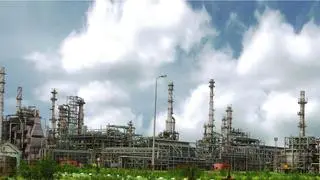Cement major Ultratech Cement reported Q2 numbers on Monday, with stellar bottomline growth of 72 per cent year-on-year (y-o-y). However, while the quarterly profit of Rs 639 crore was evidently high, it was much lower than analysts’ expectations, despite factoring in a seasonally weak quarter.
Reasons for the deviation could largely be attributed to lower-than-expected volume growth and weak realisations on account of monsoons. Ultratech also saw a 2 per cent y-o-y drop in grey cement volumes (standalone).
What went well?
The company continued to witness cost benefits on all three fronts – raw material, energy and logistics costs on y-o-y basis. Energy costs – on per tonne basis – dropped 9 per cent y-o-y to Rs 1,003 per tonne, led by continuing fall in global pet coke prices.
Despite Ultratech’s logistics mix skewed in favour of roads, it was able to reap the benefit (marginally) of the waiver in peak season railway surcharge. This led to a 4 per cent savings in logistics cost per tonne.
Consequently, EBITDA per tonne saw a 31 per cent jump to Rs 1,122.5. This came in despite a 15 per cent increase in other costs (per tonne) due to lower sales volume impacting operating leverage.
Subdued realisations
While EBITDA per tonne jumped on y-o-y basis, there was a sequential drop of 29 per cent in EBITDA per tonne. Lower realisations and increase in fly ash prices over Q1FY20 impacted the operational performance.
The company had reported its highest EBITDA per tonne in Q1FY20, attributed predominantly to cost savings and healthy realisations witnessed across cement players.
While Q2 – on account of monsoons – is a seasonally weak quarter for cement manufacturers, analysts expected volume growth to be flat. However, thanks to the growing positive sentiment around the construction space, realisations were expected to remain higher as the demand outlook remained strong. Some analysts did expect realisations to have peaked in Q1FY20 and projected a 4-5 per cent sequential drop in cement prices in Q2. But Ultratech saw a steeper 16 per cent q-o-q drop in realisations in Q2FY20.
Century acquisition & debt update
The management reiterated that the merger with Century Textiles will be effective from October 1, subsequent to transfer of mining leases. Post this, the domestic capacity of Ultratech stands at 109.4 MTPA. The acquisition – much like Ultratech’s earlier deals – brings in other added advantages. Apart from healthy limestone reserves, the company now adds another 5,000 dealers to its network, taking the total to more than 27,000 dealers.
With an additional Rs 3,000 crore of debt post acquisition, the net debt of the company stands at Rs 18,719 crore as at the end of the September quarter. This is however, 7 per cent lower than the March-end figure, thanks to the spike in cash flows on account of cut in MAT (tax) rates. As of March 2019, the company had unutilised MAT credit of Rs 1,400 crore. The corporate tax cut however, had minimal impact on the company’s bottomline.
All in all, while the benefits of the deal will be reaped in H2FY20, investors have seen a 5 per cent dilution in their stake from October (owing to shares issued to shareholders of Century Textiles). This would however, be offset by significant growth in earnings in the coming quarters, due to added capacities.
Outlook
The company continues to ride on healthy demand outlook, thanks to the Centre’s increasing thrust on infrastructure and affordable housing. That apart, healthy monsoons could be a strong rural demand driver as well.
Hence, with added capacities and continuing positive demand outlook, realisations are expected to be better in H2FY20. Ultratech is likely to outshine other cement players with its leadership position and allied cost advantages.
This is a free report from Portfolio. Click here to subscribe for more insightful and analytical reports like this .








Comments
Comments have to be in English, and in full sentences. They cannot be abusive or personal. Please abide by our community guidelines for posting your comments.
We have migrated to a new commenting platform. If you are already a registered user of TheHindu Businessline and logged in, you may continue to engage with our articles. If you do not have an account please register and login to post comments. Users can access their older comments by logging into their accounts on Vuukle.